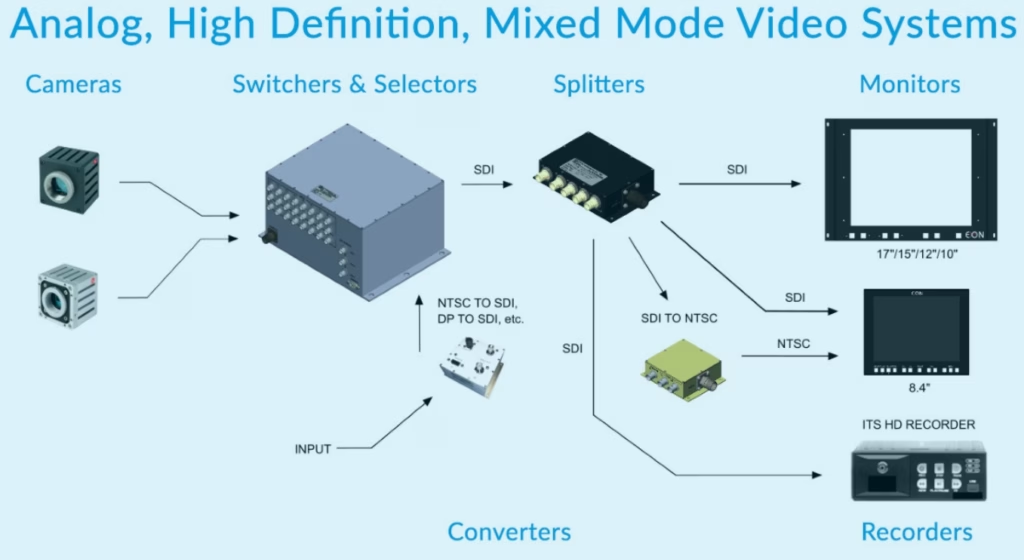What’s Best for Your Application?
In modern defence operations, video feeds are critical for real-time decision-making, surveillance, and mission success. Military platforms rely on video distribution systems for intelligence gathering, target tracking, and operational coordination. However, with both analogue and high-definition (HD) video technologies in use, choosing the right format for military applications can be complex. Let’s compare Analogue Vs. High-Definition Video in Defence Operations.
EON Instrumentation, a trusted supplier of military-grade video solutions, provides both analogue and HD video splitters that cater to a wide range of defence applications. Understanding the advantages of each format helps ensure the right technology is deployed for mission success.
The Role of Video in Defence Applications
Military video systems support various critical applications, including:
- Situational Awareness: Providing real-time visuals to operators and commanders for enhanced decision-making.
- Targeting & Weapons Systems: Ensuring accurate identification and engagement of threats.
- Surveillance & Reconnaissance: Capturing and distributing intelligence from drones, aircraft, and ground-based sensors.
- Vehicle & Aircraft Monitoring: Assisting pilots and vehicle operators with clear visuals in dynamic environments.
Choosing between analogue and HD video depends on factors such as system legacy, bandwidth availability, latency requirements, and environmental conditions.
Analogue Video: Reliable and Legacy-Compatible
Analogue video has been the backbone of military operations for decades. While considered older technology, it remains widely used due to its reliability and seamless integration with legacy defence systems.
Advantages of Analogue Video:
- Compatibility with Legacy Equipment – Many military vehicles, aircraft, and command centres still use analogue video for display and distribution.
- Low Bandwidth Requirements – Analogue video consumes significantly less bandwidth than HD, making it ideal for systems with limited data transmission capacity.
- Minimal Latency – Real-time video feeds without digital processing delays are essential for targeting and command applications.
- Proven Durability in Harsh Conditions – Operates effectively in extreme military environments with low risk of digital signal interference.
Limitations of Analogue Video:
- Lower Resolution – Analogue video lacks the clarity and detail of HD, limiting its use in high-precision surveillance and target identification.
- Limited Scalability – Not optimised for modern digital systems or future-proof applications.
High-Definition Video: Clarity and Future-Readiness
High-definition video technology offers superior image quality, making it essential for modern military applications that require enhanced visual clarity for detailed intelligence and analysis.
Advantages of High-Definition Video:
- Higher Resolution & Detail – Provides sharper images, crucial for reconnaissance, targeting, and threat identification.
- Digital Transmission & Integration – Works seamlessly with modern military networks and digital infrastructure.
- Scalability for Future Upgrades – Supports evolving military applications that demand greater visual fidelity.
- Better Data Processing & AI Integration – HD feeds are more compatible with AI-driven analysis and automated detection systems.
Limitations of High-Definition Video:
- Higher Bandwidth Requirements – HD signals require greater data transmission capacity, which may not be available in all military settings.
- Increased Latency – Depending on compression and processing, some HD formats may introduce slight delays.
- Greater Power Consumption – HD video systems often require more energy, which can be a constraint in some mobile or remote applications.
Choosing the Right Solution for Military Applications
The decision between analogue and HD video depends on operational needs, existing infrastructure, and mission requirements.
- Use Analogue Video if: You need seamless integration with legacy systems, low bandwidth usage, and minimal latency for real-time applications.
- Use High-Definition Video if: You require high-resolution imagery, advanced AI processing, and scalability for future military technology upgrades.
EON Instrumentation: Military-Grade Video Solutions
EON Instrumentation’s ruggedised analogue and HD video splitters are designed to meet the rigorous demands of military operations. Whether maintaining legacy analogue systems or upgrading to high-definition capabilities, EON provides solutions that enhance military video distribution and operational effectiveness. We hope that this comparison of Analogue Vs. High-Definition Video in Defence Operations has assisted.
As the authorised distributor for EON Instrumentation in Australia and New Zealand, we can help you select the right video distribution technology for your mission-critical applications.
